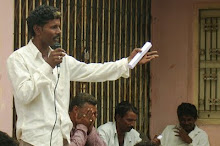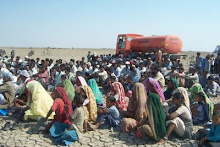Counterview: Ahmedabad: Thursday, June 20, 2013.
 |
Bal mitra in a makeshift school
|
The
state-sponsored child enrollment drive, shala praveshotsav, stressed on
enrolling children from the backward sections in Gujarat. A counterview.org
analysis, based on interview with few social workers, suggests how it would
have no lasting impact on educating kids belonging to the backward rural areas
surrounding the Little Rann of Kutch
Even as the
din around the three-day state-sponsored shala praveshotsav, which has claimed
cent per cent enrolment at the primary level in Gujarat, is starting to fade,
questions are being raised on how to retain those who have been enrolled. A
case in point is enrollment of children during the festival in the rural areas
that surround the Little Rann of Kutch. The praveshotsav took place in all the
108 villages that border the Little Rann. Helped by community based
organizations and voluntary agencies, nearly all village children were, indeed,
“enrolled”. But, apparently, this appears to the end of the roadmap for these
small kids. Already, the view is getting strong that most of these children
“would not be able to continue schooling”, as the agariya season begins. Around
14,000 saltpan workers, along with their families, including kids, would move
deep into the Little Rann of Kutch to produce salt in September, and this would
bring about a grinding halt to the children’s education, too.
The issue is
not new, though today it acquires relevance in the context of implementation of
the Right to Education (RTE) Act, under which the government is obliged to
provide every child primary school education up to the eighth standard.
Implemented late in Gujarat, in February 2012, indifference towards RTE is
nowhere more visible than vis-à-vis the agariya children. An experiment which
began several years ago – under which Rann Shalas as extensions of the regular
schools would operate to take care of education of the kids who moved to the
Little Rann – has come to a grinding halt. While lower primary children would get
regular schooling in these Rann Shalas, village hostels began to operate for
children to go to schools at the upper primary level. This was somewhat
successful, especially in the Rann area next to Surendranagar district.
However, local social workers confirm, the experiment, though remaining on
paper, is “as good as dead”. The Rann Shalas have virtually stopped
functioning, while the village hostels are in a poor shape.
 |
A tent school
|
In fact, an
endless effort has begun to pass the buck on who should do the job of providing
education to the children who move with their parents deep in the Little Rann.
Says Ghanshyam Zula of the Agariya Hit Rakshak Manch (AHRM), “In September,
hundreds of children from villages in Santalpur area in Patan district and
Adesar area of Kutch district, where I work, will start arriving with their
parents in the Little Rann to start producing salt, their only means of
livelihood. These children will remain with their parents in the Little Rann
till April, till salt is produced and sold to unscrupulous traders. These
children, already admitted in different village schools, will be at the mercy
of Sarva Shiksha Abhiyan (SSA)-run extremely poor quality make-shift schools,
where 10th the 12th pass Bal Mitras are made to teach them. While at most
places even they are quite erratic, these Bal Mitras’ main job is to bring
dropped out children back to the mainstream, yet they are made to teach agariya
children, who are already enrolled. With no ability to teach, and poorly paid,
Bal Mitras provide these children with virtually no education.”
Things are
not very different in other parts surrounding the Little Rann. Another social
worker, Marutsinh Baraiya, who works in Malia region bordering the Little Rann,
says, “It is the job of the government official, district education officer
(DEO), to ensure that children are mainstreamed into schooling when they reach
the Little Rann with their parents. However, instead of providing regular
teachers, the DEO says, it should be the job of the SSA, a Central government
scheme to fight school dropout, to run schools. The government puts most of the
children in the school dropout category, which is incorrect. The SSA, on its
part, provides Bal Mitras instead of regular teachers, and says that in case
non-government organizations come forward to do the education job, they would
be ready to help out with funds. We think, under the RTE, you just cannot evade
giving education to children like this.” He adds, “What is even more
disconcerting is the fact that the government has not cared to carry out any
survey about the plight of these children.”
A third
social worker, Bharat Samera, who works in the Surendranagar region, points
towards the way the officialdom neglects education for the children of the
Little Rann. “Each make-shift school, where the Bal Mitras come to teach, are
sanctioned Rs 30,000 for six months. Out of this, Rs 18,000 go to the Bal
Mitras, who stay in the vicinity to teach the children, while the rest goes for
the upkeep of these so-called schools. One can well imagine what can be done
with such pittance. Worse, while regular schools provide midday meal, the
agariya children in the Little Rann are are deprived of it. The SSA officials
say, it is not their job to provide midday meal to children, while the regular
school system is refusing to enter the area. At some places, chiki (sweet) and
biscuits are distributed in lieu of regular meal. Obviously, you cannot make
children survive on such items for the whole day.” Samera adds, ”Often these
makeshift schools start very late, as late as December, and wind up in April.
One can well imagine what would happen to education to the children in this
duration.”
Pankti Jog, a
senior activist with the Ahmedabad-based NGO, Janpath, who has been working
with saltpan workers for long, says, the entire agariya community faces
neglect, whether it is education or health. She says, “It is not just
education. Womenfolk, including pregnant women, of nearly 14,000 agariya
families are refused any healthcare in the entire area. The Integrated Child
Development Scheme (ICDS), under which infants should be provided with all the
basic healthcare facilities free of cost, including vaccines, does exist not
for them. In fact, there is no facility for vaccination. There are no
anganwadis. The children grow up as malnourished kids, and have little or no
option to diversify into other occupations once they age. The vicious cycle, of
becoming agariyas, awaits them. The government appears least concerned either
with their education or health.”
Meanwhile, as
the table here suggests, wide prevalent of illiteracy would mean that the
agaraiyas are simply incapable of tackling their backwardness in which they are
mired.
— Rajiv Shah

















.jpg)
.jpg)
.jpg)
.jpg)













No comments:
Post a Comment